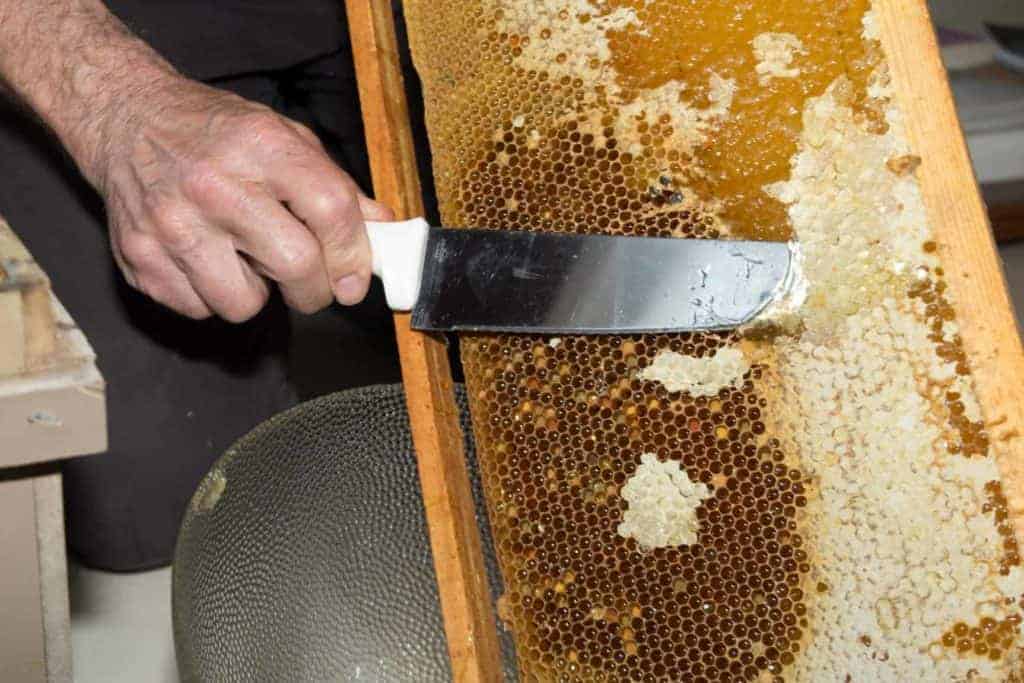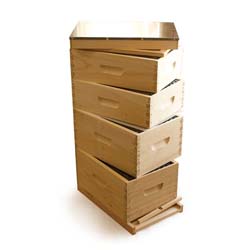For most new beekeepers, it is generally recommended not to harvest honey in the first year.
Many new hives are started with a 3-pound package of bees, in early spring, though nucs are also very popular. A package allows new beekeepers to observe and grow alongside their colony and learn the basics of hive development.
However, these bees have a lot of work to do in their first season! During the bees first year, the colony needs to…
- Build comb in brood boxes. Many beekeepers use a double-deep setup, although some use mediums.
- Fill the upper box with enough honey reserves to survive winter. Depending on whether deep or medium boxes are used, this could reach 60–80 pounds.
- Cap the stored honey with wax. This is a process where bees seal the honey with a thin layer of beeswax, once it reaches the proper moisture level. This wax seal, called a cap or cappings, helps preserve the honey for long-term storage.

If all goes well and the nectar flow is still active, you can add honey supers. However, the bees will also need to draw out comb on the frames, which is a demanding task they may not complete in their first year. Any honey stored in the supers should be at least 80% capped to ensure proper moisture content for safe storage.
Extra honey is typically harvested at the end of the nectar flow in late summer or early fall. But it is important to avoid harvesting from a weak colony, as doing so can significantly reduce its chances of surviving the winter.
Packages vs. Nucs
A nuc is a mini-colony, with workers, drones and a queen in all stages of their lives. A set of frames (typically five) will be included with the nuc. These frames will store resources, so the colony at least has that jump start.
By comparison, a package of bees is just that – bees. There are no frames and, therefore, no honey or pollen reserves. When you install a package you will learn a great deal from watching your bees, but they effectively are starting from scratch. Every frame you add to the new hive will need to be covered in cells, before honey can be stored. That’s a lot of effort for a small and young colony.
Regardless of whether a nuc or package is used, though, there is still much for the colony to do. Though a nuc is a little ahead, compared to a package, it is generally wise to let any new colony retain all the reserves they build, ahead of the winter.
Signs of a Strong and Healthy Hive (Ready for Harvest)
Though beekeepers should err on the side of caution, it is worth keeping in mind the signs that can suggest it may be OK to extract some honey.
- Deep Box Frames. All deep frames are fully drawn out with wax and filled with brood, pollen and honey.
- High Population. The hive is bustling with nurse bees inside and active foragers outside. Bees are covering nearly every frame, and at the entrance, foragers can be seen returning with pollen and nectar.
- Healthy Queen. The queen is laying a solid brood pattern (e.g., eggs, all stages of larvae, and capped brood), with no signs of disease or failure.
- Honey Stores. The hive must have adequate resources to survive the winter, typically around 60–80 pounds of honey stored in the top box. Some beekeepers use the “two-finger lift” test: place two fingers under the bottom box handle and try to lift the back of the hive. If it’s difficult or impossible to lift, the colony likely has enough honey. If it lifts easily, the stores may be insufficient.
When assessing your hives, think of your bees first. If you believe they have sufficient resources to get through the winter then you may be able to justify harvesting some for yourself. But getting through that first winter is challenging and it is advisable to let the colony build a track record of at least getting through that first winter. If unsure….leave the honey for your bees.
